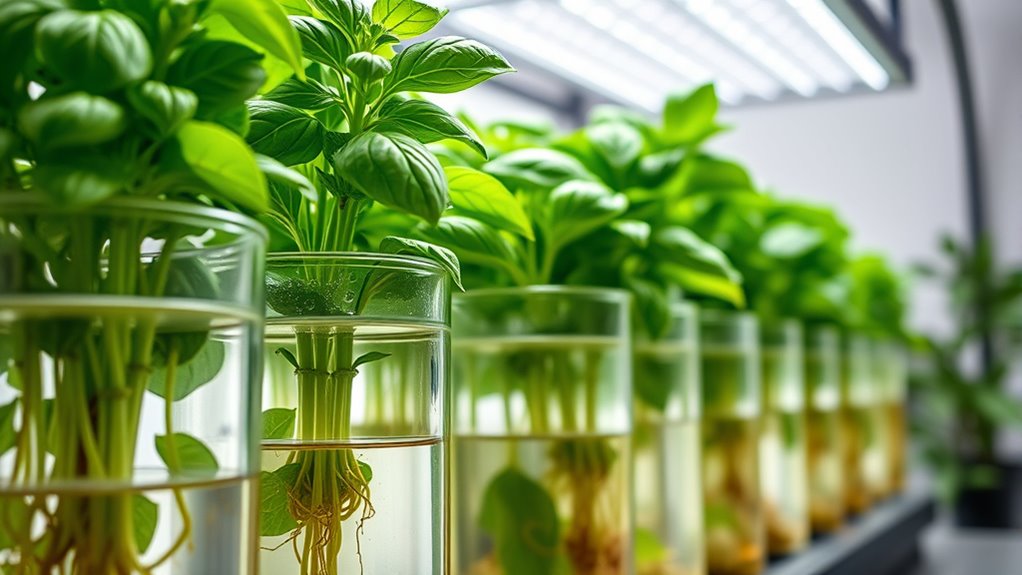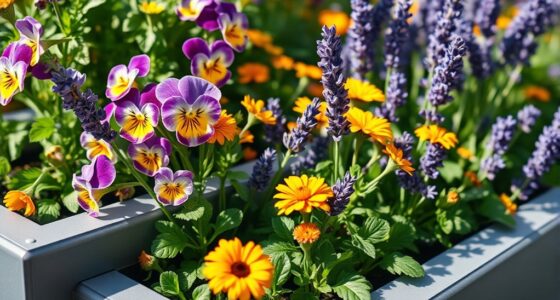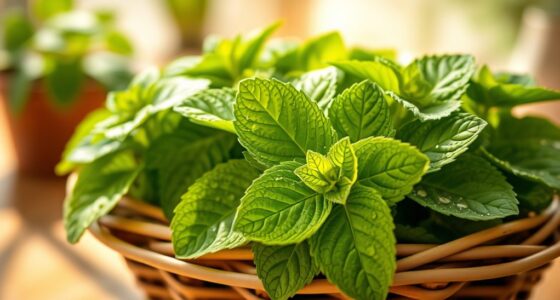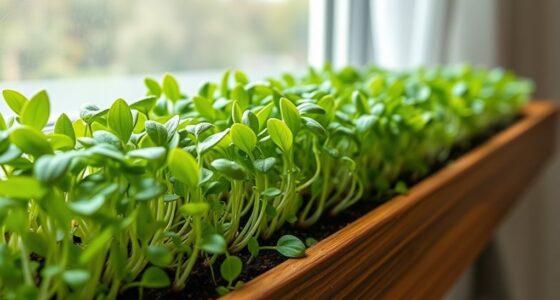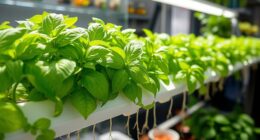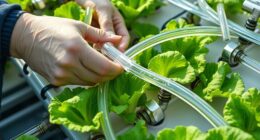To grow hydroponic basil at home, start by choosing a suitable hydroponic system and filling it with a balanced nutrient solution rich in micro and macronutrients. Keep the pH and electrical conductivity levels in check for ideal growth. Regularly inspect for pests like aphids or whiteflies, and use natural controls such as neem oil or ladybugs. Maintain good airflow and keep your environment clean. If you continue exploring, you’ll discover how to maximize your setup for lush, flavorful basil year-round.
Key Takeaways
- Select a suitable hydroponic system like NFT or deep water culture for basil cultivation.
- Use a balanced nutrient solution tailored for basil, maintaining proper pH and electrical conductivity.
- Place plants in a well-lit area with good airflow, and monitor environmental conditions regularly.
- Manage pests organically by removing damaged leaves and introducing natural predators or organic insecticides.
- Maintain cleanliness and proper watering schedules to ensure healthy growth and maximize yields.
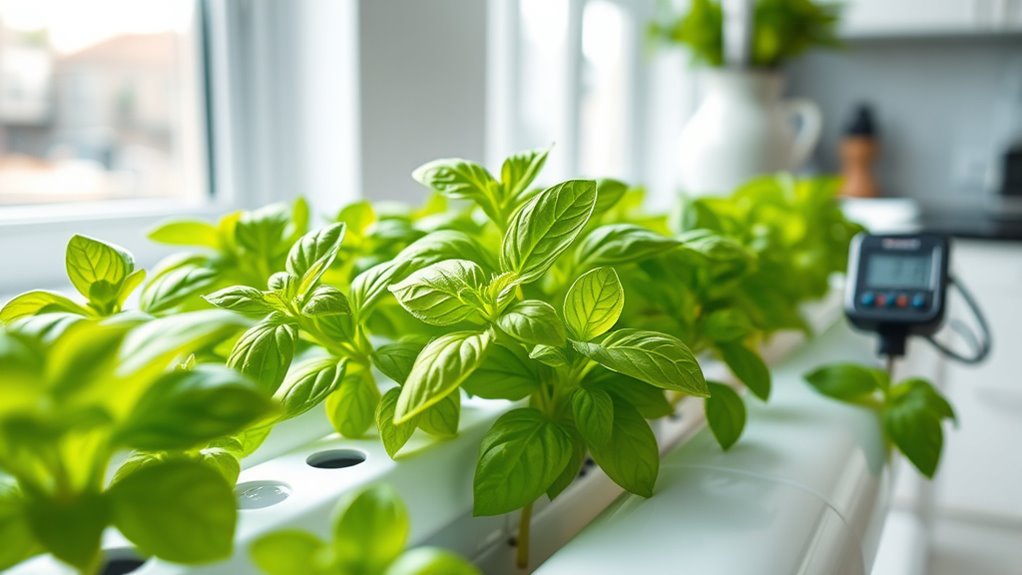
Have you ever thought about growing fresh basil right in your own home? If you’re interested in having a constant supply of vibrant, fragrant basil, hydroponic cultivation makes it easier than ever. Unlike traditional soil gardening, hydroponics involves growing plants in a nutrient-rich water solution, which allows you to control every aspect of their environment. One of the key factors in successful hydroponic basil growth is selecting the right hydroponic nutrient solutions. These solutions supply all the essential macro and micronutrients your basil needs to thrive. When choosing a nutrient mix, look for balanced formulations that promote healthy leaf development and aromatic flavor. Regularly monitor your solution’s pH and electrical conductivity to guarantee your basil absorbs nutrients efficiently. This precision feeding results in faster growth and higher yields compared to soil-based gardening.
As you set up your hydroponic system, keep in mind that basil can be susceptible to pests, even in a soilless environment. Basil pest control is vital to maintaining healthy plants and preventing infestations that can compromise flavor and growth. Common pests like aphids, whiteflies, and spider mites can still find their way onto your basil, especially if you’re growing indoors where airflow and humidity aren’t natural controls. To manage these pests, start with good sanitation practices: remove any dead or damaged leaves, and keep your grow area clean. Introducing natural predators, such as ladybugs, can help control pest populations without resorting to chemicals. If pests become a problem, you can also use organic insecticidal soaps or neem oil, which are safe for edible herbs and won’t harm your basil or your household. Additionally, understanding the importance of proper pest management can greatly improve your basil’s health and yield.
Maintaining a clean, pest-free environment is just part of successful basil pest control. Regularly inspecting your plants, especially the undersides of leaves, helps catch issues early. Keep humidity levels in check to prevent conditions that favor pest outbreaks. Good airflow around your plants discourages pest buildup and fungal problems. Additionally, avoid over-fertilizing, as excessive nutrients can weaken plants and make them more attractive to pests. When you combine the right hydroponic nutrient solutions with vigilant pest control practices, your basil can flourish in a healthy, pest-free environment. This way, you’ll enjoy fresh, flavorful basil all year round, right from the comfort of your home, with minimal fuss and maximum flavor.
Frequently Asked Questions
How Often Should I Change the Nutrient Solution?
You should change the nutrient solution every 2 to 3 weeks to maintain ideal nutrient concentration and solution freshness. Regularly check the pH and electrical conductivity (EC) levels to guarantee the basil receives proper nutrients. If you notice any algae growth or the solution turns cloudy, change it sooner. Keeping the solution fresh and balanced promotes healthy, lush basil growth and prevents nutrient deficiencies.
Can I Grow Hydroponic Basil Outdoors?
You can definitely grow hydroponic basil outdoors, especially if you enjoy outdoor gardening and want fresh herbs in your garden. Just keep in mind, basil thrives in warm, sunny conditions, so choose a spot with plenty of sunlight and good airflow. Growing indoors offers more control, but outdoor gardening can be just as rewarding. Watch out for pests and weather changes to keep your basil happy and healthy.
What Are Common Pests for Hydroponic Basil?
You’ll often encounter pests like aphids, spider mites, and whiteflies on hydroponic basil. Pest identification helps you spot problems early, so you can act quickly. Use organic pest control methods such as neem oil, insecticidal soap, or introducing beneficial insects like ladybugs. Regularly inspecting your basil plants helps prevent infestations, keeping your hydroponic system healthy and your basil thriving without chemical pesticides.
How Do I Prevent Root Rot in Hydroponic Systems?
To prevent root rot in your hydroponic system, you need to prioritize root health through regular system maintenance. Keep the nutrient solution clean and well-oxygenated, avoiding stagnant water. Check for signs of disease, and remove any affected roots promptly. Maintain proper pH levels and ensure good drainage. By staying vigilant and maintaining your system, you’ll create an environment that discourages root rot and promotes healthy basil growth.
Is Hydroponic Basil More Nutritious Than Soil-Grown Basil?
A little knowledge is a dangerous thing, but when it comes to hydroponic basil, you’re in control. Hydroponic basil often has higher nutrient concentration and vitamin content because it’s grown in ideal conditions, with nutrients directly delivered to the roots. This results in more nutritious leaves compared to soil-grown basil. So, if you want maximized nutrition, hydroponic basil might just be your best choice.
Conclusion
Now that you’ve uncovered the secrets to growing hydroponic basil at home, watch your green thumb bloom like a lush garden in spring. With each tiny sprout reaching for the light, your kitchen transforms into a vibrant oasis full of fresh, fragrant leaves. Just imagine your basil thriving, a fragrant symphony of nature’s bounty at your fingertips. Embrace the journey, and let your indoor garden flourish like a fragrant, leafy paradise—your culinary adventure begins now.
